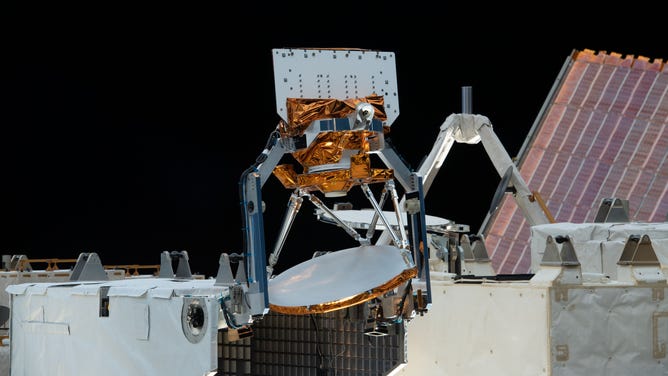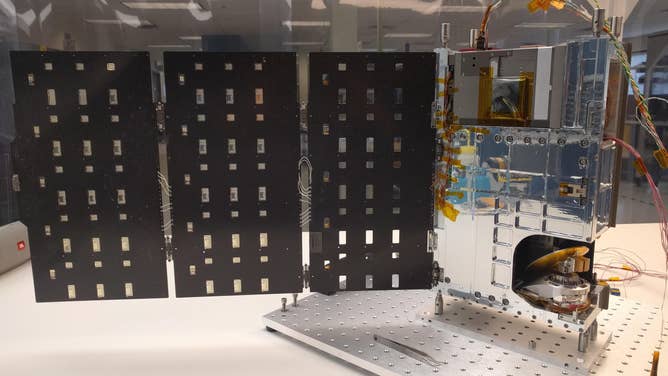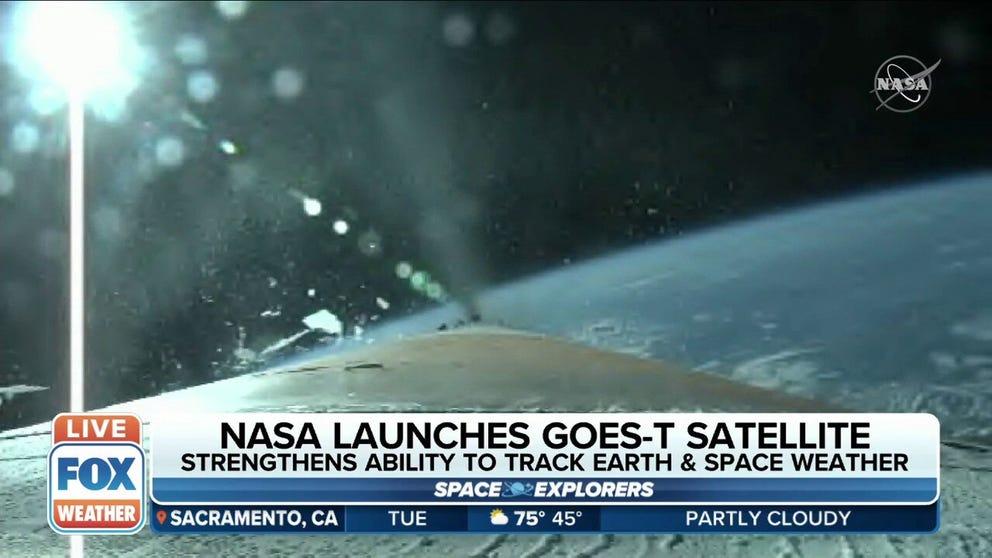Mini fridge-sized instrument in space to provide critical data for tracking tropical cyclones
Named COWVR and TEMPEST, the instruments can give forecasters a look at the internal structure of a tropical cyclone. Scientists hope that the two instruments will provide a low-cost way to supplement the information satellites provide.
NASA holds 'perfect' launch Tuesday, weather satellite begins space journey
FOX Weather digital content producer Emilee Speck on what is to come for the GOES-T satellite after launching from Kennedy Space Center in Cape Canaveral, Florida.
Two weather instruments are delivering critical weather information at a fraction of the size and cost of satellites.
Known as the Compact Ocean Wind Vector Radiometer (COWVR) and Temporal Experiment for Storms and Tropical Systems (TEMPEST), the instruments have "exceeded expectations" as trial runs, according to NASA.
Both instruments were launched to the International Space Station in late 2021, with COWVR measuring the speed and direction of wind at the ocean surface and TEMPEST providing atmospheric water vapor measurements.
How COWVR and TEMPEST help track tropical cyclones

A view of COWVR (center in white and bronze) aboard the International Space Station.
(NASA / NASA)
Data from COWVR and TEMPEST is used to produce imagery that allows the U.S. Joint Typhoon Warning Center (JTWC) to track the location and intensity of tropical cyclones, specifically between Africa’s east coast along the Indian Ocean and the west coast of the Americas along the Pacific Ocean.
HOW NASA, NOAA MAKE FORECASTING POSSIBLE
Given the vast nature of this area, NASA said additional instruments such as COWVR and TEMPEST can provide even more data on storm structure, location, wind speed and humidity to better track and understand cyclones that may form there.
"It’s challenging outside of the continental U.S. – where you don’t have weather aircraft routinely flying – to give a really good ground-truth of where these storms are, so we’re reliant on satellites," said Brian Strahl, JTWC director.
"Any new additions of good quality data, which we believe these are, can be very useful," he added.
How COWVR and TEMPEST work
The two weather instruments gather data by measuring microwave emissions from the planet’s atmosphere and surface, according to NASA.

Data from the COWVR and TEMPEST instruments aboard the ISS was used to create this image of Tropical Cyclone Mandous, which forecasters used to understand the December 2022 storm's intensity and predict its path toward southern India.
(U.S. Joint Typhoon Warning Center/U.S. Naval Research Laboratory / NASA)
Unlike data from infrared or visible light, which are detected by many instruments, data from COWVR and TEMPEST’s microwave readings can provide forecasters a look at the inside of a tropical cyclone. This helps forecast locate the eye, the center of a cyclone, even if it is covered by clouds.
In fact, microwaves are also used in Doppler radar, which uses the data to create colorful depictions of storms in weather forecasts, NASA said.
HOW WEATHER RADARS HAVE SAVED LIVES FOR OVER 30 YEARS
Supplementing information from satellites
Satellites have traditionally provided information about tropical cyclone development, but they are often large and expensive. So, scientists hope that COWVR and TEMPEST can provide a low-cost way to supplement the information satellites provide.
TEMPEST is approximately the size of a cereal box and weighs about 8 pounds, NASA said. It needs about 6.5 watts to run and costs less than $2 million to build.

Prior to being launched, here is a picture of the complete TEMPEST-D spacecraft shown with the black solar panels deployed.
(NASA/JPL-Caltech/Blue Canyon Technologies / NASA)
COWVR is approximately the size and weight of a mini fridge at 130 pounds and needs about 47 watts to run, which is around the same power necessary to run a mini fridge, according to NASA. COWVR cost about $24 million to construct.

The COWVR instrument, before it headed to the International Space Station in December 2021, during a thermal test in 2015.
(NASA/JPL-Caltech)
By contrast, NASA said the weather instrument WindSat – launched in 2003 as "the first space-bourne microwave polarimetric microwave radiometer" – weighed 990 pounds, used 350 watts to run and cost roughly five times as much as COWVR.
"NASA developed [COWVR and TEMPEST] to be compact and simple, without many moving parts, and using technology that has matured over the decades," said Shannon Brown, principal investigator for COWVR at JPL.
"We are now seeing that instruments like they can perform as well as the more expensive operational sensors," Brown added.


